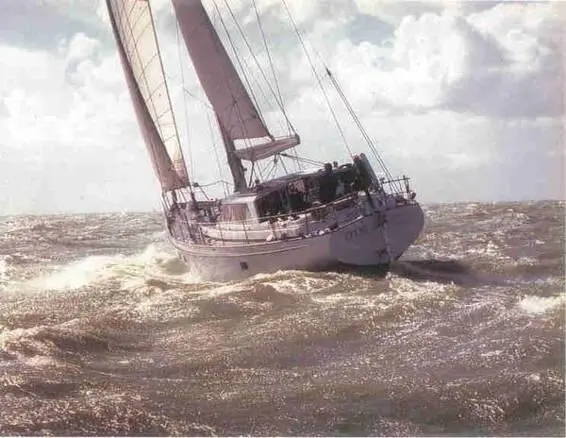The rise of the great solo and short-handed blue water races, none of which would have been feasible without the windvane gear, stimulated the professional development and construction of a wide range of different systems in England, France, Italy and Germany. The early pioneers are still familiar names: HASLER, ARIES, ATOMS, GUNNING, QME and WINDPILOT.
Several factors contributed to the rapid spread of windvane steering systems, in particular the economic miracle of the post-war years, the increasing number of series-built sailing boats and the shift in boat building away from one-at-a-time construction in wood towards mass-production with modern materials. Sailing was no longer a sport for obsessive loners or the elite and its popularity was growing.
The first companies producing professionally designed and built windvane steering systems appeared in Britain, France and Germany in 1968, and in the Netherlands not long after.
Windvane steering systems and the year they were launched:
1962: Blondie Hasler, HASLER
1962: Marcel Gianoli, MNOP
1968: John Adam, WINDPILOT
1968: Pete Beard, QME
1968: Nick Franklin, ARIES
1970: Henri Brun, ATOMS
1970: Derek Daniels, HYDROVANE
1972: Charron/Waché, NAVIK
1976: Boström/Knöös, SAILOMAT
The First Cockpit Autopilot
The first electric autopilots on non-commercial vessels probably appeared in the United States. The first TILLERMASTER, a miniaturised autopilot developed for small fishing boats, was produced in 1970.
British engineer Derek Fawcett, formerly employed at Lewmar, launched his AUTOHELM brand in 1974. AUTOHELM soon dominated the world market, its small push rod models being particularly successful. The systems were manufactured in large production runs by a work force which quickly expanded to 200.
2. Windvane Steering
Systems versus Autopilots
Our aim with this book is to investigate the functioning and the pros and cons of the various systems, and to help the reader decide which is most suitable for his or her particular needs. The two main categories of self-steering system are the autopilot and the windvane steering gear. Autopilots are electromechanical systems which obtain their steering impulse from a compass whereas windvane gears use wind and water power and obtain their steering impulse from the apparent wind angle. We will consider each in turn.
A sailing yacht generates all its drive from the position of the boat and the orientation of the sails with respect to the wind; trim the sails poorly and there will be no drive. This simple relationship explains why a windvane gear is so ideal for steering a sailing yacht. The wind angle it uses is exactly that which gives the boat drive; set this angle once and drive is assured. The benefits of steering to the apparent wind angle are particularly pronounced when sailing to weather. Even the slightest shift in the wind is immediately translated into a course change and optimum drive is ensured - a degree of sensitivity beyond even the best human helm.
Simply put, they are compact and discreet. When it comes to buying a self-steering system, probably the largest single factor counting against windvane gears is their incongruous appearance. They are generally large and bulky - hardly the ideal transom ornament. Not only that, but some are also rather unwieldy and heavy and tend to get in the way when manoeuvring in harbour under engine.
Autopilots, in contrast, are virtually invisible in the cockpit and may even be completely concealed below deck. Once installed they are simple to operate, only requiring mastery of a few buttons. Cockpit autopilots are light and generally inexpensive and they steer a compass course. For some sailors this argument is compelling; autopilots were programmed to succeed.
Over many years the sailing world polarised into two camps. In the 1970s windvane steering systems became a common sight on blue water yachts, where they were indispensable. Only in exceptional cases were they to be seen on holiday and weekend boats (and some of these can almost certainly be put down to wishful thinking!).
The debate over the last 25 years between advocates of the two different systems has been heated. One particular bone of contention was the repeated insistence of some that vessels of several tonnes or more are ‘easily’ steered with just fractions of an ampere. Views today are more realistic. There is no getting around the laws of physics: every desired ‘output’ (steering force) requires a certain ‘input’ (current/energy). Who could forget the ‘Conservation of Energy’ law so familiar from school physics lessons?
 The traditional Monitor servo-pendulum system
The traditional Monitor servo-pendulum system
3. Autopilots
How they work
Autopilots depend on a compass. A steering impulse produced by the compass actuates an electric or hydraulic motor which extends or retracts a rod or hydraulic cylinder, moving the rudder so as to bring the boat back on course. The compass carries out a desired/actual value comparison and continues the steering operation until the vessel is back on the desired course. There is a direct relationship between
· the steering force;
· the speed with which the steering force is exerted; and
· the current consumption.
The physical constants between these factors are fixed, so the only relationship which matters on a sailing yacht, steering performance (output) / current consumption (input), is always a compromise. It is never possible to obtain maximum steering performance for minimum power consumption.
This gives rise to a dilemma, since an electric motor can be geared to produce either a lot of power slowly or a little power quickly (this is analogous to the way in which a car can manage a steep gradient slowly in first gear, but not at all in top).
Autopilots are distinguished by motor capacity, this automatically fixing the relationship between the force applied by the push rod and its speed of operation. Virtually all autopilot manufacturers rely on this proven arrangement, and none has yet produced an autopilot with more than one transmission ratio and the facility to change gear.
Such pronounced gearing-down of the force from the electric motor (to produce more force at the push rod) is not practical anyway, since the corrective movement of the rudder would then be effected too slowly to bring the vessel efficiently back to the desired course. Choose a low power consumption model for a relatively heavy boat, and the steering performance will be less than wonderful. Choose a powerful autopilot, on the other hand, and no battery in the world will be able to meet the power demand without regular recharging.
Cockpit Autopilots for Tiller Steering
Push rod systems, in which an electric motor is connected via a transmission directly to a push rod, are the most straightforward form of autopilot. The push rod is extended or retracted to move the tiller.
Simple cockpit autopilots consist of a single module which includes the compass, the motor and the push rod. In larger cockpit models, the control unit and compass are separate modules which may be linked to other external transducers via a data bus. Autohelm uses the ‘ST’ (SeaTalk) designation to indicate its network-compatible systems.
Tiller push rod systems are not particularly powerful, and are therefore only suitable for smaller boats. They use relatively small (power-saving) electric motors whose force has to be multiplied by major gearing down before it is applied to the push rod. This makes them noisy and the sound of a cockpit autopilot inoperation is quite pervasive. Although they consume little power, cockpit autopilots are ponderous in their movements.
Читать дальше

 The traditional Monitor servo-pendulum system
The traditional Monitor servo-pendulum system









